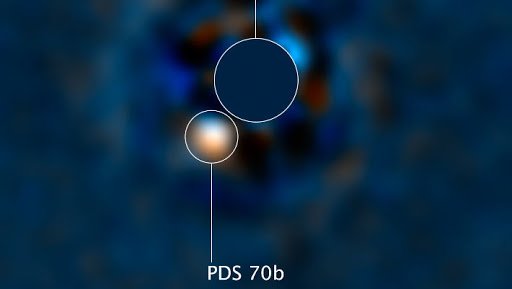The exoplanet is a planet that is located outside the solar system. The first such planet was found in the year 1917 but that exoplanet was not explored much at that time. Later in the year 1992, it had been confirmed that an exoplanet had been founded.
Youngest exoplanet: PDS 70B
Although more than 4,000 exoplanets found so far only 15 are directly imaged. And the planets are so small that they are just like dots in their images. Astronomers recently discovered an exoplanet named PDS 70b, and for the first time get a direct image of this exoplanet. Scientists old that the planet was only 5 million years old and is very young.
But the PDS 70b is still growing. Generally, such planets form as dust and gas moving in a circle, collides and settle down to form a ball. Similarly, this exoplanet is still growing by collecting the mass from stars around which it orbits. PDS 70b is already very big and similar to the size of Jupiter. It is situated 370 years away and in the constellation of Centaurus.
Believing that there might be more planets in that space astronomers searched around and interestingly found two exoplanets one they named PDS 70b and the other one as PDS 70c closely to Neptune in size but the first one was much easier to explore more about the formation of planets and many astronomical things as PDS 70c is not properly imaged by cameras.

How Hubble telescope used for locating exoplanets
The Hubble space telescope was put in the earth’s lower orbit in 1990 and still there. Not the first but the largest that remains in operating mode. This telescope was developed by NASA and ESA as a project of international operation.
Astronomers used Hubble that is in space with sensitive UV cameras. The team uses the Wide Field Camera 3 on Hubble for observing stars by rotating the telescope. They observe a star orbiting as the reflected light comes on camera from the star has an about circular shape. Thus astronomers concluded that it’s probably an exoplanet and not a star. During their observation PDS 70b as named is popped out, the other planet PDS 70c is there but that is too faint in Uv and thus not properly visible in its images.
Astronomers concluded as the planet grows the size of Jupiter in just 5 million years, it means that the growth is very fast in the past and it slows for now. The growth of this planet is in an ending state and may soon end means in a few million years it will settle down to a more stable system. The planet’s brightness is much as compared to the normal exoplanets and this concludes that the planet’s growth rate changes over some time.

“We just don’t know very much how giant planet grows” study author Brenden Bowler of the university of texas at Austin stated. “This planetary system gives us the first opportunity to witness material falling onto a planet. Our results open up a new area for this research” he further stated.
Researches said that observations of PDS 70b are not the complete picture of an exoplanet, some extra information is required to confirm the massive growth rate and to study the planet further. This would help how the planet grows. Stellar glare is a major problem faced by scientists in studying far objects like exoplanets, as they are very nearer to their host stars also. Thus by removing glare, they get a good look at the exoplanets and also clean their way for further researches to study planets that are nearer to their host stars.
Explore as much as you can who knows you might get something to be called a scientist. That’s all for now. Be in touch for further interesting facts and articles.

2 Comments
Pingback: Astronomers Discover One of The Oldest Stars in The Known Universe - Craffic
Pingback: Astronomers detect 'Moon-forming disk' around an exoplanet for the first time - Craffic